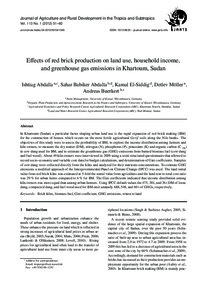| dc.date.accessioned | 2012-09-24T11:26:46Z | |
| dc.date.available | 2012-09-24T11:26:46Z | |
| dc.date.issued | 2012 | |
| dc.identifier.issn | 1612-9830 | |
| dc.identifier.uri | urn:nbn:de:hebis:34-2012061541345 | |
| dc.identifier.uri | http://hdl.handle.net/123456789/2012061541345 | |
| dc.language.iso | eng | |
| dc.publisher | Kassel University Press | ger |
| dc.rights | Urheberrechtlich geschützt | |
| dc.rights.uri | https://rightsstatements.org/page/InC/1.0/ | |
| dc.subject | Brick kilns | eng |
| dc.subject | biomass fuel | eng |
| dc.subject | Gini coefficient | eng |
| dc.subject | GHG emissions | eng |
| dc.subject | return to land | eng |
| dc.subject.ddc | 630 | |
| dc.title | Effects of red brick production on land use, household income, and greenhouse gas emissions in Khartoum, Sudan | eng |
| dc.type | Aufsatz | |
| dcterms.abstract | In Khartoum (Sudan) a particular factor shaping urban land use is the rapid expansion of red brick making (BM) for the construction of houses which occurs on the most fertile agricultural Gerif soils along the Nile banks. The objectives of this study were to assess the profitability of BM, to explore the income distribution among farmers and kiln owners, to measure the dry matter (DM), nitrogen (N), phosphorus (P), potassium (K) and organic carbon (C_org) in cow dung used for BM, and to estimate the greenhouse gas (GHG) emissions from burned biomass fuel (cow dung and fuel wood). About 49 kiln owners were interviewed in 2009 using a semi-structured questionnaire that allowed to record socio-economic and variable cost data for budget calculations, and determination of Gini coefficients. Samples of cow dung were collected directly from the kilns and analyzed for their nutrients concentrations. To estimate GHG emissions a modified approach of the Intergovernmental Panel on Climate Change (IPCC) was used. The land rental value from red brick kilns was estimated at 5-fold the rental value from agriculture and the land rent to total cost ratio was 29% for urban farms compared to 6% for BM. The Gini coefficients indicated that income distribution among kiln owners was more equal than among urban farmers. Using IPCC default values the 475, 381, and 36 t DM of loose dung, compacted dung, and fuel wood used for BM emit annually 688, 548, and 60 t of GHGs, respectively. | eng |
| dcterms.accessRights | open access | |
| dcterms.bibliographicCitation | In: Journal of Agriculture and Rural Development in the Tropics and Subtropics. Kassel : Kassel University Press. - Vol. 113, No. 1 (2012), S. 51-60 | |
| dcterms.creator | Abdalla, Ishtiag | |
| dcterms.creator | Abdalla, Sahar Babiker Ahmed | |
| dcterms.creator | Siddig, Kamal el- | |
| dcterms.creator | Möller, Detlev | |
| dcterms.creator | Bürkert, Andreas | |
| dc.description.everything | Gedruckte Ausg. im Verlag Kassel Univ. Press (www.upress.uni-kassel.de) erschienen. | ger |

